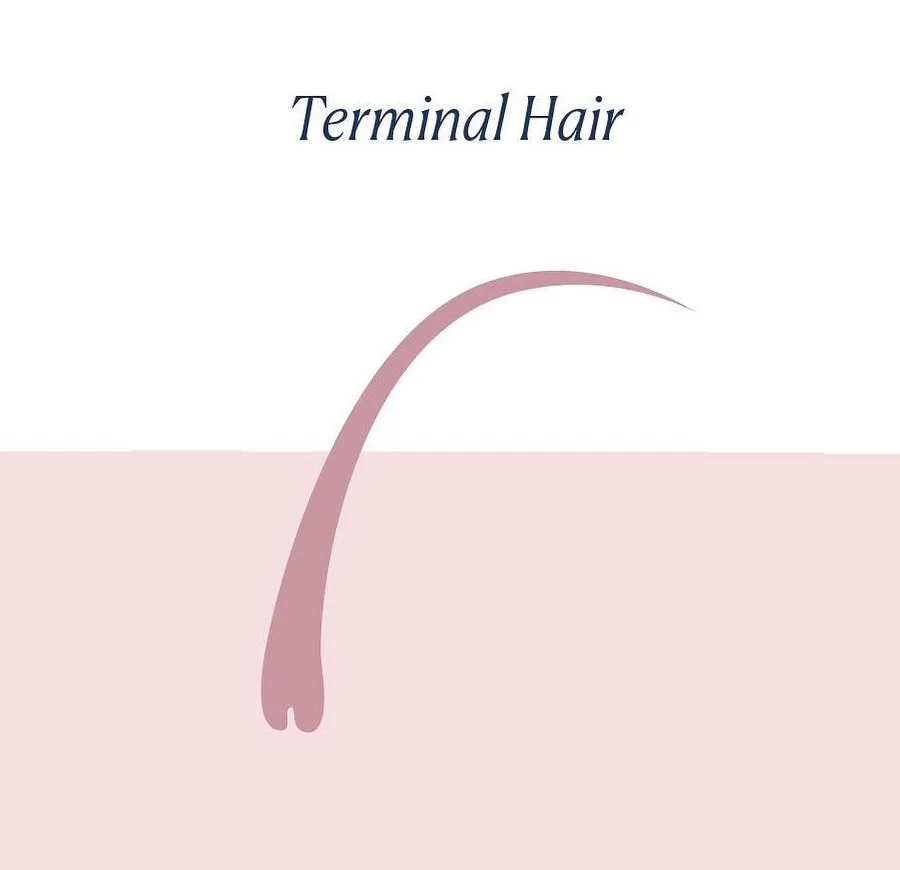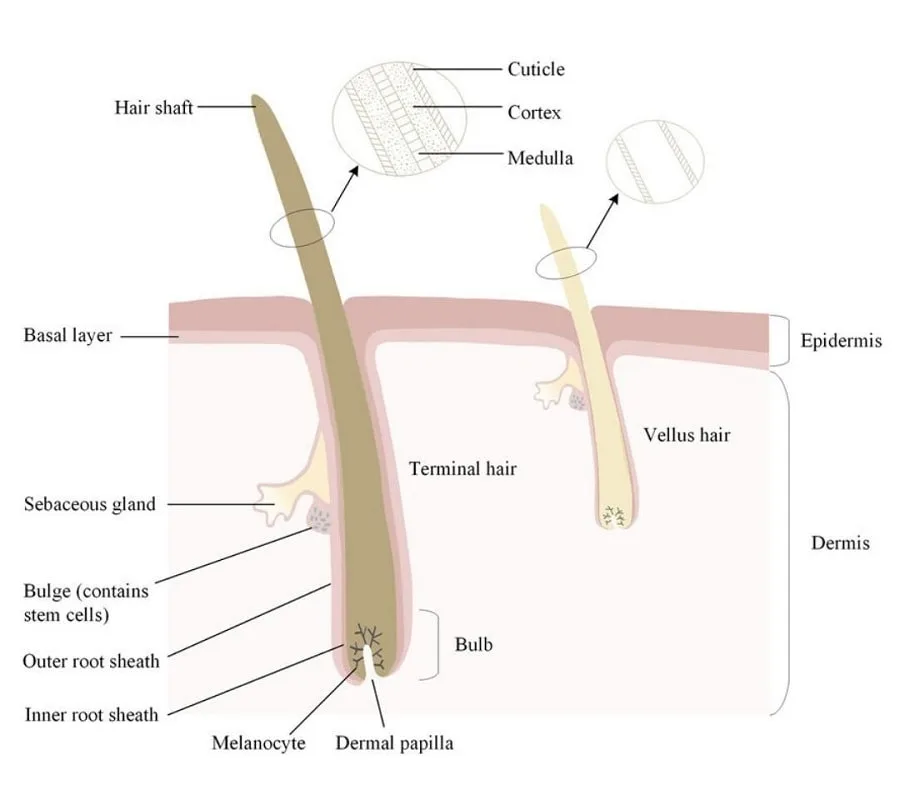Terminal hair and vellus hair are two distinct types of hair found on the human body, each with unique characteristics and functions. Terminal hair is known for its coarser texture, pigmentation, and longer length, while vellus hair is recognized for its fine, soft texture, and lighter pigmentation. The differences between these two types of hair play a crucial role in the body’s thermoregulation, protection, and overall appearance.
What is terminal hair vs. vellus hair? Let’s go into the differences between these two types of hair that everyone has on their bodies.
What Is Vellus Hair?

At the most basic level, vellus hair is the hair we have on our bodies that we sometimes refer to as “peach fuzz” around our main hairline.
Vellus hair is fine, soft, and lightly pigmented. It covers most of the body, except the palms, soles, lips, and genital areas.
Females usually have more vellus hair than males. Infants and children also have many vellus hairs. As people reach puberty, many vellus hairs change into terminal hairs.
Vellus hair serves essential functions. For example, It helps with thermoregulation, provides insulation to keep the body warm, and also wicks away sweat to cool the body down.
Vellus hair also protects the skin. It contributes to the sense of touch. It helps us perceive light objects touching our skin. For example, vellus hair lets us feel goosebumps.
Vellus hair can vary in length, thickness, and color among individuals. Abnormal growth may signal specific health conditions. If you want you can remove vellus hair. You’ll find many vellus permanent removal methods.
What Is Terminal Hair?

Terminal hair is the hair that grows from your scalp, excluding peach fuzz. It also includes armpit hair and pubic hair once puberty hits and is complete.
Terminal hair can also grow on the face. A man’s beard or stray hairs on the upper lip or chin in women are forms of terminal hair.
Eyebrows and eyelashes are also considered to be terminal hair. And chest hair is terminal hair, as is the hairline many people have from their navel to their pubic region.
What Do Vellus Hair and Terminal Hair Look Like?

Vellus hair is typically lower in pigment than terminal hair. It is shorter, not growing longer than about 5 to perhaps 10mm in length. Caucasian people typically have light brown or blond vellus hair.
People with more pigmented skin can have vellus hair that ranges in color from light brown to dark brown. In women or people without facial hair growth, vellus hair is still present on the sides of the face, although it is colorless.
Essentially any hair on an adult human body is vellus hair except for hair found on the scalp, armpits, pubic area, navel to the pubic line, eyebrows, eyelashes, and facial hair like beards and mustaches.
Terminal hair goes much deeper into the skin; you may have noticed that it’s much more painful to pluck your eyebrows or to have hair pulled out of your scalp than to lose a few hairs from your arms or legs. This is because terminal hair is rooted much deeper into your skin, which we will discuss below.
Where vellus hair is typically much less pigmented, and in some individuals, it isn’t noticeable, terminal hair is dark in color, especially for those with more melanin in their skin. People with very light blond hair can have blond scalp hair, eyebrows, and eyelashes, but they are a minority across most of the globe.
Most of the time, terminal hair is far more pigmented than vellus hair, and it appears on parts of our bodies that we would refer to as “hairy,” like our beards, armpits, pubic area, and of course, our scalps.
Now, these generalizations don’t work universally—alopecia affects approximately 1 in 1000 people worldwide, and these folks typically lose their terminal hair and most of their vellus hair.
Key Differences Between Terminal and Vellus Hair

The primary difference we’ve already discussed is color. Terminal hair, even in blond people, is more pigmented than vellus hair. The texture of vellus hair is smooth and soft. While terminal hair is thicker, which leads to it being coarser and much more noticeable than vellus hair.
Even if you could gather together enough vellus hair to make it into a ponytail, the hair is so flimsy it wouldn’t be able to stay in place.
Terminal hair is denser, which means more follicles produce hairs in a determined area than vellus hair. It is also thicker and (usually much) darker. Terminal hair begins as “peach fuzz” on your scalp before it matures into terminal hair.
Only in the situation of male pattern baldness does it then return to vellus hair. Under all other circumstances, a terminal hair stays a terminal hair. A terminal hair has follicles that reach twice as deep under the skin as vellus hairs.
Vellus Hair Vs. Terminal Hair Comparison Table
| Difference | Vellus Hair | Terminal Hair |
|---|---|---|
| Length | Short hairs (1 mm) | Long hairs (1.0 meter or longer) |
| Thickness | Thin hairs (4 microns or less) | Thick hairs (30 to 120 microns) |
| Hairs per pilosebaceous unit | More than one hair per pilosebaceous unit | Generally one hair per pilosebaceous unit |
| Pigmentation | Unpigmented | Usually pigmented |
| Life Cycle | Shorter life cycle (in telogen, 90% of time) | Longer life cycle (6 to 8 years in anagen) |
| Texture | Smooth, soft, no blunt ends | Coarser, thicker, can range from soft to rough |
| Location | Face, edges of the scalp (baby hairs/peach fuzz), arms, legs, abdomen, toes, and fingers | Facial hair (beards, mustaches), armpits, pubic region, eyebrows, eyelashes, scalp |
| Color | Ranging from no color to blond, brown, and sometimes black | All possible hair colors are found across the world, but much more pigmented than vellus |
| Density | Variable | Three to four hairs per follicle: average; five to six hairs per follicle: high |
| Diameter | Less than 0.03mm | More than 0.03mm, usually more than 0.06mm |
| Follicle Depth | Reticular dermis (0.6mm from the skin surface) | Sebaceous gland (2-5mm from the skin surface) |
In short, your scalp, eyebrows, and eyelashes are terminal hair at birth. Everything else is vellus hair until puberty.
Then vellus hair on your pubic region, armpits, and face (in some cases) becomes terminal hair and stays that way unless pattern baldness develops. Most of the hair on your body is vellus hair, but the hair you groom and style is typically terminal hair.
